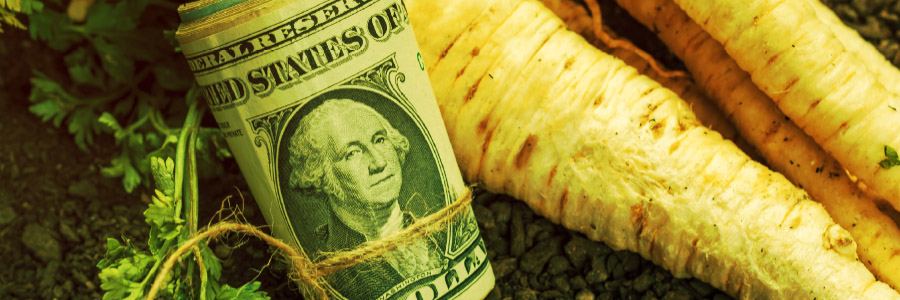


Sign-up for {N}power to get exclusive discounts, newsletters, members-only features, and more!


When the Green Revolution began to take off in the middle of the 20th century, it was a promise of abundant food; selective breeding resulted in high-yielding crops and irrigation allowed food to be grown in places where it couldn’t before. There was a major shift in the way food was grown—industrial-scale agriculture surpassed small to mid-sized family farms as a means to feed millions of Americans. It has become the dominant food production system, but it is a system that is defined by monoculture cropping that relies heavily on synthetic chemical fertilizers and pesticides (a broad term which include insecticides, herbicides, and fungicides). There is an emphasis on growing commodity crops like corn and soy that end up as animal feed and in processed junk food. Industrial animal production has grown alongside industrial agriculture, in which a single species of animal is raised in concentrated animal feeding operations (CAFOs) to satisfy our desire for cheap meat.
The cheap and abundant food that has proliferated in the U.S. relies on a system of agriculture that is costing us all. Costs that are passed on to taxpayers, farm workers, rural communities, our collective public health, and the environment.
Let’s take a look at some of the hidden costs of conventional agriculture.
While food prices have naturally climbed over the years, Americans still spend a fairly small percentage of their income on food. That’s in large part due to agricultural subsidies, which are meant to maintain a stable food supply at relatively low costs, or so it seems.
The U.S. spends about $20 billion annually on farm subsidies.1 These payouts were originally introduced in the 1930s as, “a temporary solution to deal with an emergency;”2 in other words, to help the small and mid-sized family farms that were hit hard by the Depression and severe weather issues like the Dust Bowl that left crop fields barren. These days, they are intended to protect farmers from the variables of farming—weather, pests, market prices, etc.— and alleviate farmer poverty, but in reality, the majority of subsidies go to large commercial farms with average incomes of $200,000 and average net worths of about $2 million.3 One analysis found that 60 percent of subsidies went to the largest 10 percent of farms.4
Subsidies are supposed to help compensate for the risks of farming, but these payouts essentially give billions of taxpayer dollars to large farm businesses. More than 90 percent of all subsidies go to five crops: wheat, cotton, corn, soybeans, and rice. These subsidies create a surplus of these crops, which are mostly used to make processed junk food or to feed livestock in CAFOs. Meanwhile, more than half of the fresh fruit and almost a third of the fresh vegetables we buy is imported from other countries.5 Subsidies aren’t the only economic costs of conventional agriculture—the estimated environmental and public health care costs of excessive pesticide use has been estimated to be about $12 billion dollars annually6 and the cost of treating rural and municipal drinking water supplies contaminated by agricultural fertilizer pollution is in the billions.7
Conventional agriculture relies on large-scale monoculture, meaning farmers grow or produce a single crop or livestock species in one field or farm at a time. This kind of intensive farming requires using (literally) tons of synthetic chemical fertilizers and pesticides.
In fact, the U.S. uses more than one billion pounds of pesticides each year, according to the Environmental Protection Agency (EPA).8 About 85 pesticides used throughout the U.S. have been banned or are in the process of being phased out in Europe, China, and Brazil, mostly because of their harmful impact on human health or the environment, according to a 2019 study published in the journal Environmental Health. 9
A reliance on monocultures and the heavy use of pesticides that this type of farming requires leads to a loss of biodiversity,10 including beneficial pollinators, whose numbers have been drastically declining in recent years. Biodiversity boosts overall ecosystem health and ensures that ecosystems can endure and recover from natural disasters and climate instability.11
In addition to biodiversity, water is also highly affected by agricultural runoff.
Runoff from fields washes pesticides and fertilizers into lakes, rivers, and streams, impacting local wildlife and drinking water for nearby residents. Nitrate, in particular, is one of California’s most widespread groundwater pollutants and studies are ongoing about its potential risk to human health.12 The UC Davis Center for Watershed Sciences studied the link between agriculture and groundwater and found that “agricultural fertilizers and animal wastes are by far the largest regional sources of nitrate in groundwater, contributing 96 percent of the nitrate loading to groundwater in these agricultural regions.”13
Dead zones and algae blooms resulting from agricultural runoff are an ever-growing problem as well. The historic flooding of millions of acres of Midwestern farmland earlier this year washed huge amounts of fertilizer and manure into waterways, “triggering a potentially unprecedented season” of algae blooms in Lake Erie and the Gulf of Mexico.14 An algae overgrowth can choke out aquatic life and make water unsafe for swimming and drinking. Further, algae blooms emit large amounts of methane, a potent greenhouse gas, which scientists say can accelerate global methane emissions up to 90 percent over the next century.15
Conventional agriculture also takes a major toll on the soil. Heavy tilling, multiple harvests of the same crop every year, and the heavy use of chemicals depletes valuable soil nutrients and microbes, requiring farmers to use ever increasing amounts of chemical fertilizers to stimulate plant growth. The heavy use of pesticides further depletes important soil microorganisms. The herbicide glyphosate, for example, has been found to negatively impact the diversity, function, and structure of soil microbes and fungi that are vital to soil health.16
A recent United Nations study found that one-third of the Earth’s fertile soil is being “acutely degraded.” The biggest factor? Conventional agriculture.17 Soil degradation leads to erosion and eventually desertification, making it harder to continue farming and threatening food production.18 Degraded soil also releases carbon into the atmosphere, making it a major contributor to climate change.19 20
One of the biggest threats of conventional farming to human health is the rise of antibiotic-resistant superbugs, or bacteria that don’t respond to antibiotics. The CDC calls antibiotic resistance, “one of the world’s most pressing public health problems.”21
About 80 percent of all antibiotics in the U.S. are not used by humans,22 instead, they are administered to cows, pigs, and chickens raised for food in an attempt to keep them healthy in CAFOs. One study found that people living near pig farms or cropland fertilized with pig manure were about 30 percent more likely to contract antibiotic-resistant Staphylococcus aureus bacteria, or MRSA.23
The widespread use of chemical pesticides in conventional agriculture is another major health burden placed on the public, and often, the people most affected by them are also the least protected. Farmworkers are on the frontlines working with harmful pesticides, often with very little training or understanding of how the exposure can affect their health. Studies have shown that pesticides brought into the home on parents’ clothing and skin also put farmworker’s children at risk.24 One long-term study conducted by researchers at the University of California, Berkeley found that the children of farmworkers and children who lived near fields where organophosphate pesticides are sprayed had higher rates of neurodevelopmental problems, including autism, hyperactivity, and reduced IQs.25 26
The damage isn’t limited to farmworkers and their children. More than 90 percent of the U.S. population has detectable levels of pesticides, or their metabolites, in their bodies; most of the exposure comes from food and drinking water. Cumulative and chronic pesticide exposure has been linked to numerous health problems, including cancer, reproductive and endocrine problems, neurodegenerative disorders, cardiovascular disease, and respiratory conditions.28 29 30
Finally, there’s the issue of food subsidies. Scientists have tracked how subsidized foods affect our health and found that people whose diets contained more subsidized foods (i.e., foods that are highly processed) tended to have worse health than those whose diets contained less.31
Industrial agriculture produces commodity crops like corn and soybeans, which make cheap, overly processed foods. A number of recent studies have found that eating processed foods leads to overeating and weight gain, a higher risk of cardiovascular disease, an increase in cancer risk, and overall risk of all-cause mortality.32

The goal of organic agriculture is to conserve and improve soil health and water resources; foster biodiversity; and grow food without the use of synthetic fertilizers and pesticides. When it comes to livestock, organic standards require that animals are managed without the preventative use of antibiotics, are fed certified organic feed, meet certain health and welfare standards, and are managed in a way that conserves natural resources and biodiversity.33
Conventional agriculture was promised to feed the world, but side-by-side studies comparing organic and conventional farming practices have found that organic systems can match or surpass conventional farming in production.
A Rodale Institute report found that organic farming “consistently matched the yields of the conventional system, and produced greater yields than the conventional system under moderate drought conditions.”
Their research also found that organic systems were almost three times as profitable as the conventional ones;34 other research has also found that organic hotspots, or counties with high levels of organic agricultural activity, boost household incomes and reduce poverty levels.35
And while conventional agriculture is a major contributor of greenhouse gases, research has shown CO2 emissions to be up to 66 percent lower in organic farming systems compared to conventional ones.36 37 Organic farming also focuses on restoring soil health, and healthy soil sequesters carbon, helping to reduce CO2 levels in the atmosphere.38 It has been estimated that for each one percent increase in soil carbon levels due to organic farming, atmospheric CO2 levels would be reduced by up to two percent.39
Cheap food is plentiful in the U.S. as a result of an unsustainable system of agriculture, one that comes at a major cost to the economy, the environment, and public health. And those costs are shouldered not by the industry causing the damage, but by individual farmers, farmworkers, taxpayers, and the general public. There is a better way. Organic agriculture is a system that boosts the economy, while protecting the environment and public health— with no hidden costs.



Sign-up for {N}power to get exclusive discounts, newsletters, members-only features, and more!